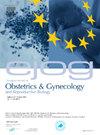骶骨结肠成形术中的后方网片固定与非固定:随机临床试验
IF 2.1
4区 医学
Q2 OBSTETRICS & GYNECOLOGY
European journal of obstetrics, gynecology, and reproductive biology
Pub Date : 2025-03-10
DOI:10.1016/j.ejogrb.2025.03.025
引用次数: 0
摘要
本文章由计算机程序翻译,如有差异,请以英文原文为准。
Posterior mesh fixation versus non-fixation in sacrocolpopexy: A randomized clinical trial
Introduction
Urogenital prolapse affects up to 50% of women, and its treatment is essential for improving quality of life. Laparoscopic sacrocolpopexy is considered the gold standard, but there is no consensus on the optimal surgical approach. This study tests the hypothesis that the absence of posterior mesh fixation is non-inferior to its fixation.
Materials and Methods
We conducted a randomized, single-blinded, monocentric, non-inferiority trial in Italy (NCT04358978). In Group A, the posterior mesh was placed without fixation, while in Group B, it was fixed to the rectovaginal fascia and levator ani muscle. The primary outcome was the correction of prolapse, with secondary outcomes including intraoperative parameters, postoperative characteristics, and urogenital prolapse correction at 1, 6 and 12, months, as well as long-term morbidity.
Results
120 women were randomized into two groups with no significant differences. At 12 months, both groups reported no bulge symptoms, and pelvic pain was 3,3 %. Urinary dysfunction decreased in both groups, with a reduction in de novo incontinence (Group A: 1.6 %, Group B: 3.3 %) and persistent incontinence (Group A: 0 %, Group B: 7 %). Persistent constipation at 12 months was 3.3 % in Group A and 13 % in Group B. No cases of obstructed defecation or mesh erosion were observed. Five cases of failure (8.3 %) were reported in both groups, defined as Ba point reaching the hymen.
Conclusions
The absence of posterior mesh fixation is non-inferior to fixation in laparoscopic sacrocolpopexy in terms of treatment success and postoperative complications.
求助全文
通过发布文献求助,成功后即可免费获取论文全文。
去求助
来源期刊
CiteScore
4.60
自引率
3.80%
发文量
898
审稿时长
8.3 weeks
期刊介绍:
The European Journal of Obstetrics & Gynecology and Reproductive Biology is the leading general clinical journal covering the continent. It publishes peer reviewed original research articles, as well as a wide range of news, book reviews, biographical, historical and educational articles and a lively correspondence section. Fields covered include obstetrics, prenatal diagnosis, maternal-fetal medicine, perinatology, general gynecology, gynecologic oncology, uro-gynecology, reproductive medicine, infertility, reproductive endocrinology, sexual medicine and reproductive ethics. The European Journal of Obstetrics & Gynecology and Reproductive Biology provides a forum for scientific and clinical professional communication in obstetrics and gynecology throughout Europe and the world.

 求助内容:
求助内容: 应助结果提醒方式:
应助结果提醒方式:


